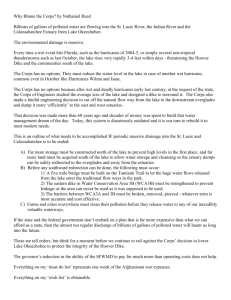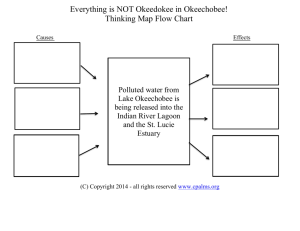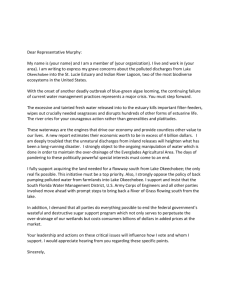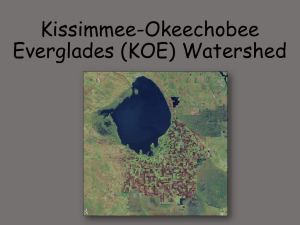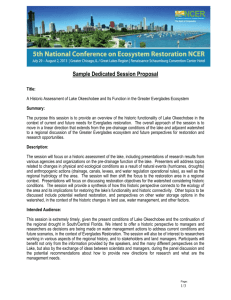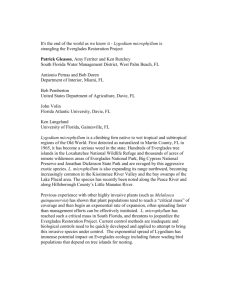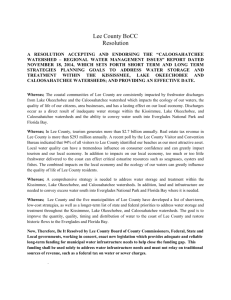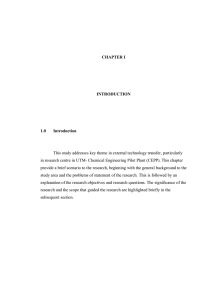Document 10614965
advertisement
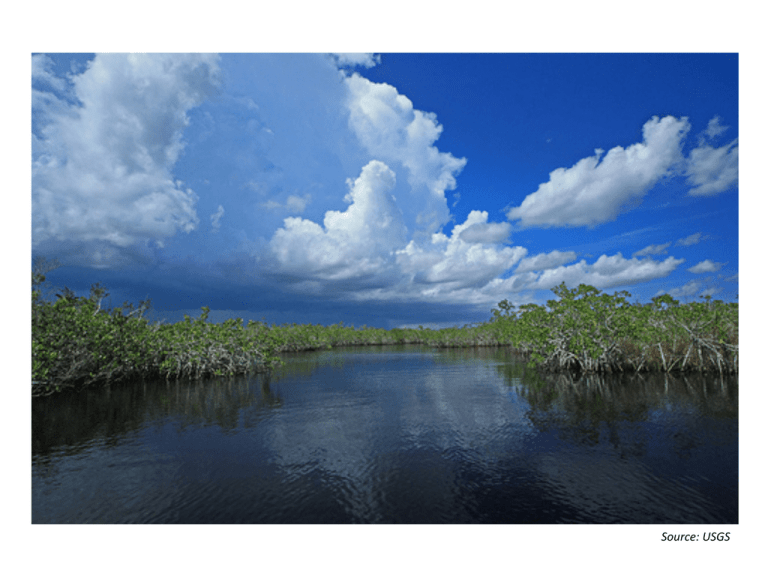
Source: USGS Outlook on Everglades Restora2on Karl Havens, Director, Florida Sea Grant University of Florida /IFAS khavens@ufl.edu This presentaCon summarizes results of an independent study commissioned by the FL Legislature in 2014: Op-ons to reduce high volume freshwater flows to the St. Lucie and Caloosahatchee Estuaries and move more water south from Lake Okeechobee to the Southern Everglades – an independent technical review by the University of Florida Water Ins-tute Authors: Wendy Graham, Mary Jane Angelo, Thomas Frazer, Peter Frederick, Karl Havens and K. Ramesh Reddy Available online: hSp://waterinsCtute.ufl.edu/ Then search on publicaCons Background • Independent review was commissioned by the Florida Senate in response to stakeholder concerns about Everglades restoraCon • Prompted by large regulatory releases from Lake Okeechobee to the St. Lucie and Caloosahatchee estuaries in 2013 • The UF team reviewed and analyzed exisCng plans and idenCfied constraints to implemenCng them • We also considered opCons not currently in any approved plans Findings South Florida has a complex hydrology. SoluCons are constrained by: • Times of over and under-­‐abundance of water • Poorly suited topography, geology and hydrology for storing and moving water • Stringent water quality standards • Yet huge water quality issues, especially north of Lake O • Strongly compeCng user groups AcCons in one part of the system have o^en resulted in tradeoffs, either intenConal or unintenConal, in other parts. Findings • There are no short term easy soluCons. • Local estuary basins account for 65-­‐80% of the water and nutrient loads to the estuaries • UlCmate soluCon is enormous increases in storage and treatment north, south, east and west of Lake Okeechobee • 160,000 addiConal acre-­‐^ east • 400,000 addiConal acre-­‐^ west • 900,000 to 1,200,000 addiConal acre ^ north, south and in the lake • Bo4om line: exis2ng projects are insufficient to achieve restora2on goals How did this shor@all in storage occur ? ASR – Aquifer Storage and Recovery, a core feature of CERP CERP planned number of regional wells: 330 ASR wells, 1.7 BGD capacity for storage NaConal Research Council esCmate of what is possible (2015 review): 131 ASR wells What major projects are underway ? Many. I will showcase one prime example that is focused on restoring flow of clean water to the Everglades, called CEPP (Central Everglades Planning Project). CEPP 1 Store and Treat 2 Distribute 3 Convey 4 Prevent Seepage Expected CEPP outcomes • Increases delivery of clean water to the Everglades by over 1.5 million acre feet per year • However, only reduces damaging discharges to St. Lucie and Caloosahatchee estuaries by less than 55% • And, sCll less than 75% of the dry season target flows will be delivered to the Everglades CEPP alone is not sufficient to restore the Everglades or stop the damaging flows to the east and west estuaries. So what else could be done ? US Army Corps of Engineers 1994 South Florida Water Management District 2010 South Florida Water Management District 2010 Projected outcomes of ROG scenarios 7 of the opCons considered in modeling ‘Op2on Lands’ Short-­‐term Recommenda7ons • Accelerate funding and compleCon of exisCng federally authorized projects specifically designed to provide relief to the estuaries (IRL-­‐S and C-­‐43 projects) • Develop more aggressive BMPs for Lake Okeechobee and St. Lucie and Caloosahatchee estuaries • Accelerate the authorizaCon, design and construcCon of state and federal projects designed to provide addiConal clean water south to the EPA (RestoraCon Strategies and CEPP) … parallel where possible • Accelerate the USACE dam safety study so that modificaCons to the Lake Okeechobee scheduled can be made But these will not be sufficient to achieve restora2on goals Longer-­‐term Recommenda7ons • Develop and execute a strategic plan to provide addiConal storage and treatment north of the lake • Develop and execute a strategic plan to provide addiConal storage and treatment south of the lake • Consider deep well disposal as an emergency opCon to reduce damaging discharge to the estuaries unCl addiConal storage and treatment capacity can be constructed • PotenCal changes in climate, demographics, energy costs and land use should be explicitly incorporated into future restoraCon project planning. Bo9om Line • Many exisCng plans and projects have been fully veSed and can be expected to yield substanCal benefits • Most of the projects are delayed because of a lack of funding • Increased and sustained funding is criCcal to provide addiConal water storage and treatment before the system becomes so degraded that major aSributes reach Cpping points that cannot be reversed • Planned storage capacity falls far short of what is needed to restore the regional system Thank you Source: USGS
